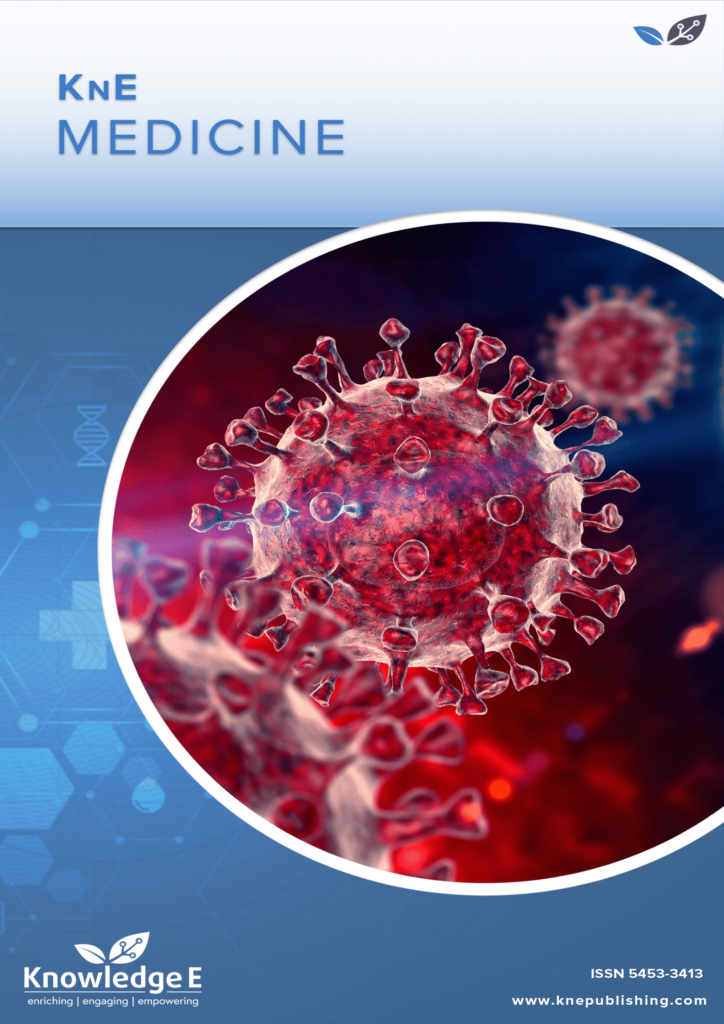
KnE Medicine
ISSN: 2519-125X
The latest conference proceedings on all fields of medicine.
Curcuma Longa Herbs: A Mechanism to Increase the Innate Immune Response Through a Pharmacological System Approach
Published date: Sep 15 2022
Journal Title: KnE Medicine
Issue title: The International Conference of Medicine and Health (ICMEDH)
Pages: 263–271
Authors:
Abstract:
Innate immunity is the body’s first line of defense against infection. One form of the innate immune response is the production of the antimicrobial peptide cathelicidin, which has many important roles in the host immunity against tuberculosis infection, as well as being an antimicrobial therapy. This study’s objective was to determine the potential effect of Curcuma longa, an herb commonly found in Indonesia, to increase the production of the antimicrobial peptide cathelicidin, and its interaction patterns in cells using an in silico approach. The data on the chemical content of the plant were gathered from the Dr. Duke Phytochemical Database, with the prediction of absorption, distribution, metabolism, and excretion (ADME) of compounds in the plant’s rhizomes conducted using the Swiss ADME Software. The Swisstargetprediction.ch website was used to predict the relationship of the plant compounds with cell proteins, and STRINGDB was used to look for pharmacological networks. The results showed that C. longa enhances innate immunity through the activation of TLR7/9 and other related proteins. The findings also showed that the activation of the innate immune response is followed by activation of the adaptive immune response along with its related proteins.
Keywords: antimicrobial peptide, cathelicidin, C. longa, pharmacological network
References:
[1] Rajamanickam A, Munisankar S, Dolla CK, Babu S. Diminished systemic and mycobacterial antigen specific anti-microbial peptide responses in low body mass index-latent tuberculosis co-morbidity. Front Cell Infect Microbiol. 2020 Apr;10:165.
[2] Silva JP, Appelberg R, Gama FM. Antimicrobial peptides as novel anti-tuberculosis therapeutics. Biotechnol Adv. 2016 Sep-Oct;34(5):924–40.
[3] Cirone KM, Lahiri P, Holani R, Tan YL, Arrazuria R, De Buck J, et al. Synthetic cathelicidin LL-37 reduces Mycobacterium avium subsp. paratuberculosis internalization and pro-inflammatory cytokines in macrophages. Cell Tissue Res. 2020 Jan;379(1):207–17.
[4] Chromek M, Slamová Z, Bergman P, Kovács L, Podracká L, Ehrén I, et al. The antimicrobial peptide cathelicidin protects the urinary tract against invasive bacterial infection. Nat Med. 2006 Jun;12(6):636–41.
[5] Atanasov AG, Waltenberger B, Pferschy-Wenzig EM, Linder T, Wawrosch C, Uhrin P, et al. Discovery and resupply of pharmacologically active plant-derived natural products: A review. Biotechnol Adv. 2015 Dec;33(8):1582–614.
[6] Jankun J, Wyganowska-Świątkowska M, Dettlaff K, Jelińska A, Surdacka A, Wątróbska-Świetlikowska D, et al. Determining whether curcumin degradation/condensation is actually bioactivation (Review). Int J Mol Med. 2016 May;37(5):1151–8.
[7] Daina A, Michielin O, Zoete V. SwissADME: A free web tool to evaluate pharmacokinetics, drug-likeness and medicinal chemistry friendliness of small molecules. Sci Rep. 2017 Mar;7(1):42717.
[8] Daina A, Michielin O, Zoete V. SwissTargetPrediction: Updated data and new features for efficient prediction of protein targets of small molecules. Nucleic Acids Res. 2019 Jul;47(W1 no. W1):357–64.
[9] Szklarczyk D, Gable AL, Lyon D, Junge A, Wyder S, Huerta-Cepas J, et al. STRING v11: Protein-protein association networks with increased coverage, supporting functional discovery in genome-wide experimental datasets. Nucleic Acids Res. 2019 Jan;47:607–13.
[10] Wu J, Liu L, Hu H, Gao Z, Lu S. Bioinformatic analysis and experimental identification of blood biomarkers for chronic nonunion. J Orthop Surg Res. 2020 Jun;15(1):208.
[11] Farouk F, Shamma R. Chemical structure modifications and nano-technology applications for improving ADME-Tox properties, a review. Arch Pharm (Weinheim). 2019 Feb;352(2):1800213.
[12] Wen PP, Shi SP, Xu HD, Wang LN, Qiu JD. Accurate in silico prediction of species-specific methylation sites based on information gain feature optimization. Bioinformatics. 2016 Oct;32(20):3107–15.
[13] Dripps DJ, Verderber E, Ng RK, Thompson RC, Eisenberg SP. Interleukin-1 receptor antagonist binds to the type II interleukin-1 receptor on B cells and neutrophils. J Biol Chem. 1991 Oct;266(30):20311–5.
[14] Smith LM, Weissenburger-Moser LA, Heires AJ, Bailey KL, Romberger DJ, LeVan TD. Epistatic effect of TLR-1, -6 and -10 polymorphisms on organic dust-mediated cytokine response. Genes Immun. 2017 Mar;18(2):67–74.
[15] Koehn J, Huesken D, Jaritz M, Rot A, Zurini M, Dwertmann A, et al. Assessing the function of human UNC-93B in Toll-like receptor signaling and major histocompatibility complex II response. Hum Immunol. 2007 Nov;68(11):871–8.
[16] Huang C, Luo Y, Zhao J, Yang F, Zhao H, Fan W, et al. Shikonin kills glioma cells through necroptosis mediated by RIP-1. PLoS One. 2013 Jun;8(6):66326.
[17] Kielbik M, Szulc-Kielbik I, Klink M. IRAK1 and IRAK4 signaling proteins are dispensable in the response of human neutrophils to Mycobacterium tuberculosis infection. FEMS Microbiol Lett. 2019 Sep;366(18):https://doi.org/10.1093/femsle/fnz226
[18] Q. Meng, W. Zhang, X. Xu, et al. The effects of TRAF6 on proliferation, apoptosis and invasion in osteosarcoma are regulated by miR-International Journal of Molecular Medicine. https://doi.org/10.3892/ijmm.2018.3458.